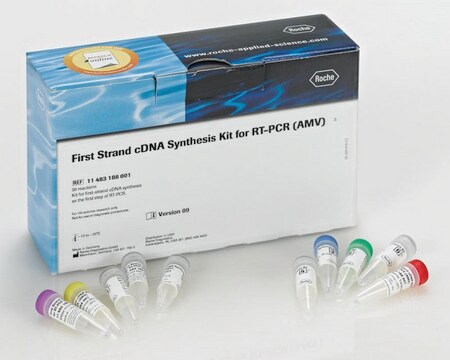Wichtige Dokumente
10109118001
Roche
Reverse Transcriptase AMV
solution, >50 units/μg protein, suitable for RT-qPCR, suitable for RT-PCR
Synonym(e):
amv reverse transcriptase
About This Item
Empfohlene Produkte
Form
solution
Qualitätsniveau
Spezifische Aktivität
>50 units/μg protein
Leistungsmerkmale
dNTPs included: no
hotstart: no
Verpackung
pkg of 1,000 U
Hersteller/Markenname
Roche
Lagerbedingungen
avoid repeated freeze/thaw cycles
Parameter
42 °C optimum reaction temp.
Methode(n)
RT-PCR: suitable
RT-qPCR: suitable
Aufnahme
purified RNA
Nachweisverfahren
probe-based
Verwandte Kategorien
Allgemeine Beschreibung
The enzyme can also be used for RNA sequencing, 3′ end labeling of DNA fragments, and the generation of ss probes for genomic footprints.
Reverse Transcriptase AMV requires a primer and Mg2+ or Mn2+ for activity.
Spezifität
Heat inactivation: 5 min, 95 °C
Anwendung
- First- and second-strand cDNA synthesis and synthesis of first strand cDNA for use in subsequent amplification reactions (RT-PCR)
- Dideoxy DNA sequencing
- Primer extension
- RNA sequencing
- 3′-end labeling of DNA fragments
- Generation of single-stranded probes for genomic footprint experiments
Leistungsmerkmale und Vorteile
- Efficiently transcribes total RNA, mRNA, viral RNA and RNA rich in secondary structures
- Procure full length cDNA fragments up to 12 kb
- Higher thermostability (up to 60°C) and specificity than M-MuLV Reverse Transcriptase
Verpackung
Qualität
Function test: Reverse Transcriptase AMV is function tested in the cDNA Synthesis Kit and RT-PCR.
Einheitendefinition
Volume Activity: 20-25 U/μl. Please refer to the Certificate of Analysis for more information.
Angaben zur Herstellung
Lagerung und Haltbarkeit
Sonstige Hinweise
Nur Kit-Komponenten
- Reverse Transcriptase AMV 20-25 U/μl
- First-strand cDNA Synthesis Buffer 5x concentrated
Lagerklassenschlüssel
12 - Non Combustible Liquids
WGK
WGK 1
Flammpunkt (°F)
does not flash
Flammpunkt (°C)
does not flash
Hier finden Sie alle aktuellen Versionen:
Besitzen Sie dieses Produkt bereits?
In der Dokumentenbibliothek finden Sie die Dokumentation zu den Produkten, die Sie kürzlich erworben haben.
Kunden haben sich ebenfalls angesehen
Verwandter Inhalt
In der RT-qPCR oder quantitativen PCR mit reverser Transkription werden die Effekte der reversen Transkription und der quantitativen PCR oder Echtzeit-PCR zur Amplifikation und zum Nachweis spezifischer Ziele kombiniert. Die RT-qPCR wird in vielen Anwendungen eingesetzt, darunter die Quantifizierung der Genexpressionsniveaus, die Validierung der RNA-Interferenz (RNAi) und der Nachweis von Krankheitserregern wie Viren.
Unser Team von Wissenschaftlern verfügt über Erfahrung in allen Forschungsbereichen einschließlich Life Science, Materialwissenschaften, chemischer Synthese, Chromatographie, Analytik und vielen mehr..
Setzen Sie sich mit dem technischen Dienst in Verbindung.





![Verbesserte aviäre reverse Transkriptase [eAMV™ RT] For reverse transcription at higher temperatures & rare mRNAs](/deepweb/assets/sigmaaldrich/product/images/496/245/af9bcef6-1474-494b-8fba-32ca0fd56c42/640/af9bcef6-1474-494b-8fba-32ca0fd56c42.jpg)




